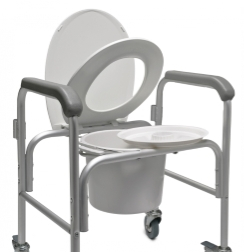A Comprehensive Guide on How to Use a Bedside Commode

This detailed guide outlines all the necessary steps and precautions involved in how to use a bedside commode. This article aims to provide essential information to caregivers and individuals who rely on the use of a bedside commode due to limited mobility or other health-related issues.
What Is a Bedside Commode?
A bedside commode, often referred to as a portable toilet, does not require running water to operate. It resembles a chair outfitted with a toilet seat and is equipped with a removable bucket or container beneath the seat. This mobile commode can be conveniently placed next to a bed, facilitating ease-of-use for individuals who are unable to easily access the washroom. The commode may be fitted with lockable wheels for easy movement and secure use.
Why Would One Need a Bedside Commode?
The use of a bedside commode becomes necessary when an individual is required to stay bedridden for extended periods. It proves particularly beneficial for those who are weak, unsteady, or at an increased risk of falls. By providing a safe and convenient alternative to walking to the bathroom, the commode aids in preserving the individual’s dignity and independence.
Preparations Before Using a Bedside Commode
To ensure a smooth and hygienic experience when using a bedside commode, a few necessary items must be prepared in advance. These include:
- Disposable gloves
- Toilet paper or wet wipes
- A container with warm, soapy water
- A washcloth
- A towel
How to use a Bedside Commode
1. Placement of the Commode
The commode should be positioned next to the person’s bed, ensuring it is easily accessible yet not obstructive. The container must be appropriately placed beneath the seat, and a small quantity of water can be added to facilitate easier cleaning afterward.
2. Safety Measures
Before the person uses the commode, the wheels (if any) must be locked to prevent any accidental movement. If a seatbelt is available and required, it should be securely fastened around the person for additional safety.
3. Privacy Considerations
Once the person is safely seated on the commode, they should be afforded privacy if it is safe to do so. Providing them with a bell or similar device can allow them to signal when they are done or require assistance.
After the Person has Finished Using the Commode
1. Personal Hygiene
Upon completion, a pair of disposable gloves should be worn before assisting the person to stand. If the individual requires help with cleaning, use toilet paper or wet wipes first, followed by a warm soapy washcloth. The area should then be gently dried with a towel. If the person has managed to clean themselves, help them wash and dry their hands before assisting them back to bed.
2. Cleaning the Commode
After the person is safely back in bed, remove the container from the commode and carry it to the bathroom. Lift the toilet seat and carefully pour the contents of the container into the toilet. Proceed to clean the container using a toilet brush, germ-killing cleanser, and water. Rinse thoroughly and replace the container under the commode. Finally, dispose of the used gloves properly.
Regular Use of the Bedside Commode
To manage incontinence effectively, encourage the person to use the commode at regular intervals, such as every 2 to 4 hours. Maintaining a consistent schedule can help prevent accidents and improve overall comfort.
Creating a Comfortable Environment
Helping someone with a commode can be an awkward experience for both parties involved, especially if they are of the opposite sex. Maintaining a calm demeanor and showing understanding can help alleviate embarrassment and make the person feel more at ease.
Safety Precautions
Ensure the person is wearing non-slip footwear to prevent falls. Clothes that are easy to remove can also make the process of using the commode less challenging. Be mindful to lock the wheels of the commode before use, and assist the person with getting on and off the commode, ensuring they do not lose balance or tip the commode.
Final Thoughts
Knowing how to use a bedside commode is crucial for caregivers and individuals who rely on one for their daily needs. By following the steps outlined in this guide, you can ensure a safe, hygienic, and dignified experience for all involved.
Always remember that each individual’s needs are unique, and adjustments may be necessary depending on specific circumstances. Always consult with healthcare providers for personalized advice and support.
By understanding and implementing these instructions, you are not only providing essential care but also upholding and respecting the dignity of the person in your care. Let this guide serve as your comprehensive manual for how to use a bedside commode effectively and compassionately.


